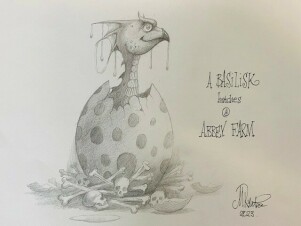English Writing
To support children to achieve their full potential in writing, quality texts are chosen as a termly stimulus for English which will fascinate and engage. A planned sequence of teaching is followed in order to enable the children to meet a specific end of unit writing outcome; one for fiction and one for non-fiction.
 AFET Dragon drawn by visiting author Mark Robertson
AFET Dragon drawn by visiting author Mark Robertson
The sequence begins with sharing the text followed by detailed analysis. Key vocabulary and phrases from the text are highlighted and studied to expand the children’s word understanding. Weekly grammar lessons are followed by opportunities for the children to practice these skills independently in their own writing. Each unit culminates in an end of unit write which will use the learning from the whole unit. Children are taught editing and revising skills in order to improve their own work. We use CLPE and a carefully crafted Reading Spine developed for our children at AFET.
Throughout the year children will write for a variety of purposes and audiences across fiction and non-fiction. Writing to entertain includes description, poetry and story writing. Story writing covers six basic story plots and children also focus on a different non-fiction writing purpose including to inform, to argue and to explain, appropriate to their age and ability including a variety of text types: recount (newspaper and diary), report, instruction, explanation, discussion and persuasion. When a text type has been covered there are short burst opportunities for children to revise these throughout the year including outside of the English lesson in Topic, Science or Learn Together lessons. Children are supported by guided and modelled writing.
In Reception the children are encouraged to write through a range of mark making activities and opportunities, including Greg Bottrill's drawing club which runs twice a week. We believe that children do not need to be seated at a table to learn, develop and most importantly be self motivated and passionate about writing. Opportunities can be given through chalk outside to post it note messages . . the opportunities are endless and our staff are passionate about investing in these whilst the children are at play.
In year 1 this is further developed with the use of a tutor table. A teaching session is held with the class and then children work in small groups, with the teacher, for more intensive and small group learning. It allows a higher level of engagement with each child and meets the needs more impactfully.
There are high expectations of handwriting across the curriculum areas.
EYFS: Children strengthen their fingers in preparation for writing through daily funky fingers tasks (Funky Fingers is designed to be a quick activity, which develops children's fine motor skills and hand-eye coordination) as well as starting in pre-school with Squiggle While you Wiggle, which continues into Reception.
Children learn the correct letter formation in Reception daily phonics lessons alongside using the scheme Letterjoin to form precursive patterns. It is essential that children learn correct letter formation; starting in the correct place with movement in the correct direction are to be preferred to uniformly regular letters achieved through wrong movements. See the Letter Formation Instruction sheet in the gallery below, which show the letters with red starting buttons and arrows for direction of movement.
Fine and gross motor skills are developed through a range of activities. In terms 5 and 6 children begin to form precursive letters. In precursive writing children begin each letter from the line using a lead-in and a lead-out to aid the joining of letters.
Key Stage 1: Precursive handwriting is taught in year 1 as children continue to learn forming precursive letters correctly. Diagonal and horizontal joins are introduced and practiced regularly with children all using neat, cursive handwriting by year 2.
Key Stage 2: When we open years 3 to 6 cursive handwriting will be developed so that children can write fluently with stamina for more prolonged periods.




